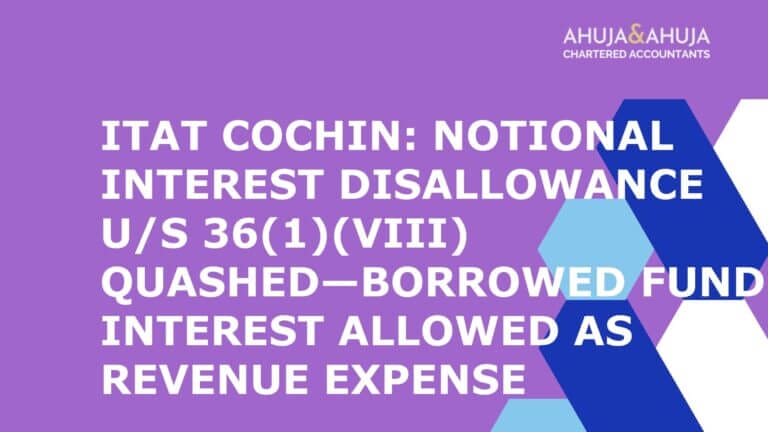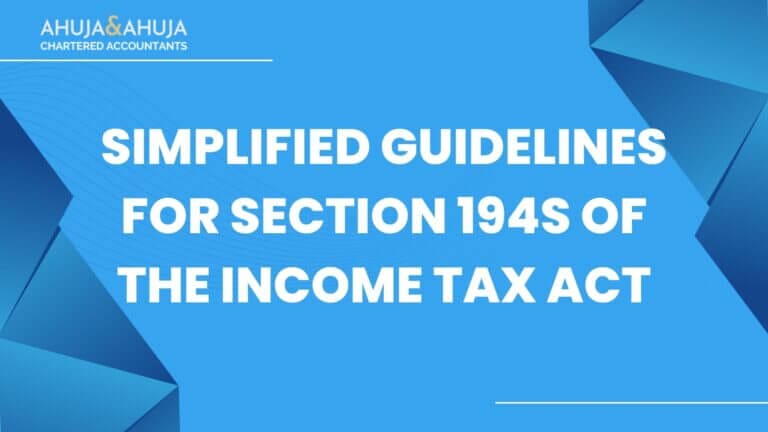Use of Gift as Colourable Device to attain eligibility for exemption u/s 54F Not Allowed: Hyderabad ITAT
In a landmark judgment that reverberates through the corridors of tax planning and legal stratagems, the Hyderabad Bench of the Income Tax Appellate Tribunal (ITAT) laid down a decisive ruling concerning the use of what it determined to be a “colourable device” in tax evasion schemes, particularly disallowing an exemption under Section 54F of the Income Tax Act, 1961.
This case highlights the intricate balance between legitimate tax planning and the abuse of a tax benefit offered by the legislation.
The case in point revolves around a taxpayer who, in apparent readiness for an impending property sale, gifted an existing property to his father.
This strategic move, coming right before the sale of another asset, was allegedly intended to ensure compliance with the criteria set forth by Section 54F, which is primarily designed to encourage investments in residential properties by offering exemptions on capital gains tax, under specific conditions.
Understanding the nuances of this section is critical to grasp the significance of the Tribunal’s decision. For a detailed read on capital gains and exemptions, you can visit Understanding Section 54.
Context and Background of the Case
In the fiscal year 2014-2015, the taxpayer engaged in a series of meticulously timed transactions. Firstly, on October 27, 2014, he executed a deed gifting a residential property he owned to his father. Notably, at the time of this gift, another residential property was registered in his name.
Just a week later, on November 3, 2014, he entered into an agreement to sell a piece of land, a deal finalized with prior receipt of a portion of the consideration from the buyer. This was followed by another agreement on January 30, 2015, where he aimed to purchase a new residential property.
Each of these transactions, chronologically aligned, was pivotal in understanding the taxpayer’s eligibility for the exemption under Section 54F.
The exemption under this section is quite specific: it is applicable only when the taxpayer does not own more than one residential house prior to the purchase of the new asset, aside from the new asset being bought within a stipulated period after the sale of a previous asset.
Analysis of the Transactions
The timeline of the transactions raises important questions:
- October 27, 2014: Gift of residential property to father.
- November 3, 2014: Sale agreement of land.
- January 30, 2015: Purchase agreement of new residential property.
The proximity of these transactions—especially the gift just days before the land sale—provides a critical backdrop for the allegations of tax evasion.
The authorities argued that the gift was not an act of genuine transfer of asset but rather a strategic move to fit into the confines of Section 54F’s exemptions.
The timing and the continued residence of the taxpayer in the gifted property contributed to the skepticism of the Tax Authorities.
Tax Authorities’ View and Initial Assessment
Upon reviewing the transactions, the Tax Authorities were quick to notice the strategic timing and sequence of the property gift just prior to the land sale.
Their suspicion was primarily anchored in the idea that the gift was transacted to artificially create eligibility for claiming the capital gains tax exemption under Section 54F.
Instead of viewing the gift as an independent act of familial generosity, it was seen as a maneuver to reduce the apparent number of residential properties owned by the taxpayer, just before the sale of a significant asset.
The authorities argued that the mere separation of seven days between the gift and the subsequent sale, coupled with the fact that the taxpayer continued to reside in the gifted property, indicated a lack of genuine transfer of interest and possession.
Moreover, they emphasized that such arrangements appeared designed to avoid the requisite tax liabilities straightforwardly.
Ruling by CIT (A) and Tribunal
The Commissioner of Income-tax (Appeals) – CIT (A), upon hearing the appeal, sided with the tax authorities and cited established legal precedents Supreme Court ruling in McDowell, which frown upon the use of colourable devices as a means of tax evasion.
The CIT (A) reiterated that while tax planning is permissible within the framework of the law, exploiting legal loopholes to fabricate a situation where tax benefits are unjustly claimed falls outside the bounds of acceptable financial conduct.
Upon further appeal to the Hyderabad ITAT, the Tribunal delved deeper into the context and motivations behind the transactions. The taxpayer’s defense highlighted the independent familial and emotional reasons for the gift and argued the coincidence of the timing.
However, the ITAT focused on the broader financial implications and the sequence of the transactions. It noted that the obligations and rights associated with the residential properties had not substantively changed post-gift, thereby questioning the genuineness of the transfer.
Judicial Insight and Verdict
The Tribunal applied a holistic approach to discern the essence of the arrangement. It referenced relevant sections of the Indian Contract Act, 1872 particularly focusing on provisions that invalidate agreements made with the intent of evading the law.
The ITAT ruled that the entire scheme of transactions, when seen in conjunction with each other, demonstrated a clear intent to manipulate the provisions of the tax law to personal benefit.
The Tribunal’s final judgment was stern and clear: it upheld the ruling of the lower tax authorities, concluding that the arrangement was indeed a colourable device intended to circumvent the legal obligations of capital gains tax, thus disallowing the claim for exemption under Section 54F.
Implications of the Ruling and Navigating Tax Planning vs. Tax Evasion
Implications for Taxpayers
The decision from the Hyderabad ITAT has set a precedent that may affect many taxpayers who engage in property transactions as part of their tax planning strategies.
Essentially, this ruling concretizes the distinction between admissible tax planning and unacceptable tax avoidance:
- Scrutiny of Transaction Timing and Purpose: Taxpayers need to be aware that the timing and context of their transactions will be scrutinized. Transactions orchestrated in close succession with significant financial undertakings, like selling a capital asset, will be examined for genuineness and substance over form.
- Genuine Transfer of Rights and Possession: Simply transferring the title of a property without the concurrent transfer of possession and enjoyment of rights might not suffice to prove the separation of property ownership, especially when exemptions related to capital gains are involved.
- Increased Documentation and Justification: Taxpayers might need to provide additional documentation and justification for transactions involving property, particularly when these are performed close to the transaction of a sale of an asset eligible for tax benefits.
Legal Distinction Between Tax Planning and Tax Evasion
The Tribunal’s reliance on previous Supreme Court rulings, particularly distinguishing between legitimate avenues of tax mitigation and impermissible tax evasion, underscores a critical judicial perspective:
- Tax Mitigation: This refers to the usage of the tax regime in a way that is within the legal framework, designed to reduce tax liability without deceit. This form of planning respects the legal boundaries and purposes of the law.
- Tax Evasion: This involves using deceitful, misleading, or outright illegal means to reduce one’s tax liability. It often involves manipulation of transactions or omission of facts to misrepresent the true nature of transactions to the tax authorities.
Navigating the Guidelines
For taxpayers considering complex transactions involving property or other significant assets, the following guidelines can serve as a navigational beacon:
- Transparent Transaction Motives: Ensure that the motives and purposes of major transactions are transparent and justifiable, not just from a financial or legal standpoint, but also in their timing and method.
- Consultation with Tax Professionals: Prior to engaging in activities that might significantly affect tax liabilities, consulting with tax experts or legal advisors can provide insights into the compliance requirements and the potential risks involved.
- Detailed Documentation: Maintaining detailed records and documents related to the transactions can provide substantial support during any scrutiny or assessment by tax authorities.
Conclusion
The Hyderabad ITAT’s ruling is a pivotal moment in the interpretation of tax laws relating to property transactions and capital gains.
It serves as a reminder that while tax planning is an essential aspect of financial management, crossing into the realm of tax evasion can lead to significant legal repercussions.
Taxpayers must navigate this landscape with care and diligence, ensuring their actions adhere not only to the letter but also to the spirit of the law.
For further reading and a deeper understanding of property-related tax implications, visit our guides on tax planning through house property.
This wraps up our detailed examination of the Hyderabad ITAT’s ruling. Stay informed and compliant, and always approach tax planning with both strategy and integrity.
Disclaimer
The materials provided herein are solely for educational and informational purposes. No attorney/professional-client relationship is created when you access or use the site or the materials. The information presented on this site does not constitute legal or professional advice and should not be relied upon for such purposes or used as a substitute for professional or legal advice.







